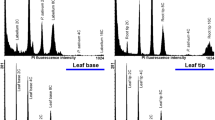Abstract
Protocorm-like body (PLB) and subsequent shoot development in hybrid Cymbidium Twilight Moon ‘Day Light’ can be established in vitro via 3 pathways: PLBs, PLB thin cell layers (TCLs), or embryogenic callus (EC). Traditionally Cymbidium hybrids are mass-produced commercially through the neo-formation of secondary PLBs (2° PLB) from initial or primary PLBs (1° PLB) or PLB segments, or from PLB TCLs, resulting in a moderate number of 2° PLBs (average 4.46 2° PLBs/1° bisected PLB, or 1.12 2° PLBs/ PLB TCL). This study shows that EC can be induced from 1° PLBs or PLB TCLs. Thereafter, resulting 2° PLBs (average 22.1 2° PLBs/EC cluster derived from 1° PLB) form directly from the EC on the same medium or following the transfer of EC onto PGR-free medium. By flow cytometry and PCR-RAPD analysis, the cytogenetic stability of 1° PLBs, of resulting 2° PLBs and EC, and plants derived therefrom was demonstrated.



Similar content being viewed by others
References
Begum AA, Tamaki M, Tahara M, Kako S. 1994a. Somatic embryogenesis in Cymbidium through in vitro culture of inner tissue of protocorm-like bodies. J Jpn Soc Hort Sci 63:419–427
Begum AA, Tamaki M, Kako S. 1994b. Formation of protocorm-like bodies (PLBs) and shoot development through in vitro culture of outer tissue of Cymbidium PLB. J Jpn Soc Hort Sci 63:663–673
Chang C, Chang WC. 1998. Plant regeneration from callus culture of Cymbidium ensifolium var. misericors. Plant Cell Rep 17:251–255
Fujii K, Kawano M, Kako S. 1999. Effects of benzyladenine and α-naphthaleneacetic acid on the formation of protocorm-like bodies (PLBs) from explants of outer tissue of Cymbidium PLBs cultured in vitro. J Jpn Soc Hort Sci 68:35–40
Fukai S, Hasegawa A, Goi M. 2002. Polysomaty in Cymbidium. HortScience 37:1088–1091
Huan LVT, Tanaka M. 2004. Callus induction from protocorm-like body segments and plant regeneration in Cymbidium (Orchidaceae). J Hort Sci Biotech 79:406–410
Lavrentyeva AN. 1986. Characteristics of microclonal propagation of several kinds of Cymbidium hybrids. In Conservation and cultivation of orchids. 3rd All Union Conf Proc 64–65
Morel GM. 1960. Producing virus-free Cymbidium. Am Orch Soc Bull 29:473–478
Obara-Okeyo P, Kako S (1998) Genetic diversity and identification of Cymbidium cultivars as measured by random amplified polymorphic DNA (RAPD) markers. Euphytica 99:95–101
Teixeira da Silva JA. 2003. Thin cell layer technology in ornamental plant micropropagation and biotechnology. African J Biotech 2:683–691
Teixeira da Silva JA, Singh N, Tanaka M. 2005a. Priming biotic factors for optimal protocorm-like body and callus induction in hybrid Cymbidium (Orchidaceae), and assessment of cytogenetic stability in regenerated plantlets. Plant Cell Tiss Org Cult 84:100119–100128
Teixeira da Silva JA, Yam T, Fukai S, Nayak N, Tanaka M. 2005b. Establishment of optimum nutrient media for in vitro propagation of Cymbidium Sw. (Orchidaceae) using protocorm-like body segments. Propagation Ornamental Plants 5:129–136
Teixeira da Silva JA, Tanaka M. 2005. Analysis of suitability of DNA extraction protocols for somaclonal variation analysis in in vitro-cultured orchids. Acta Hort (in press)
Vacin E, Went FW. 1949. Some pH changes in nutrient solution. Bot Gaz 110:605–613
Acknowledgments
The authors are grateful to the Japanese Society for the Promotion of Science (JSPS) for financial support to J.A.TdS., and to Prof. Seiichi Fukai for assistance with SEM. The revision services at http://scirevision.client.jp are acknowledged.
Author information
Authors and Affiliations
Corresponding author
Rights and permissions
About this article
Cite this article
Teixeira da Silva, J.A., Tanaka, M. Multiple Regeneration Pathways via Thin Cell Layers in Hybrid Cymbidium (Orchidaceae). J Plant Growth Regul 25, 203–210 (2006). https://doi.org/10.1007/s00344-005-0104-0
Received:
Accepted:
Published:
Issue Date:
DOI: https://doi.org/10.1007/s00344-005-0104-0




